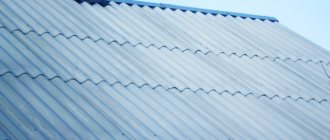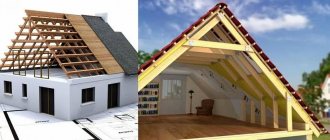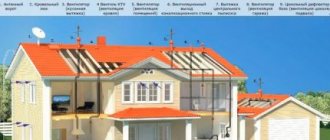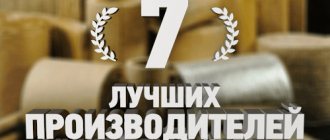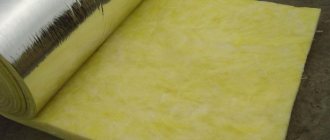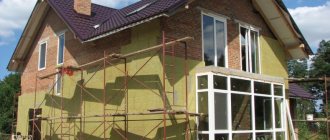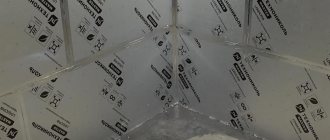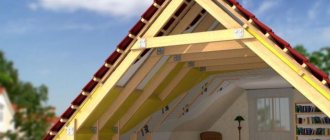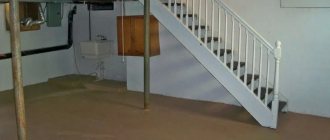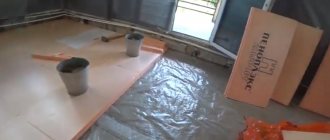Roof insulation - advanced technologies:
- Expanded polystyrene
- Penoplex
- Minvata
- Polyurethane foam
- Penoizol
- Ecowool
- Sawdust
- Expanded clay
How to insulate different types of roofs:
- Mansard roof
- Cold roof
- Attic
- Flat roof
- Garage
Cost of roof insulation
Insulation of the roof of an enterprise
Air heated in a room is known to rise.
If the roof is not insulated, the heat leaves the house and goes outside.
Therefore, roof insulation is one of the most effective heat-saving measures.
Currently, there are many materials and methods of thermal insulation of roofs.
We invite you to further familiarize yourself with the most advanced and effective technologies.
Insulating the roof of a building - basic methods and materials
The concept of “ roof insulation ” means the creation of a thermal insulation layer that prevents heat from escaping outside, that is, keeps it indoors.
For these purposes, materials with low thermal conductivity are used.
As a rule, they have a cellular or fibrous structure and low density.
As a result, most of their volume is occupied by air, which is one of the best heat insulators.
The exception is polyurethane foam, which we will discuss in more detail below.
All options for insulating roofs of buildings can be divided into two types:
- internal - the most common method, which is most often used for thermal insulation of pitched roofs, but can also be used for flat structures;
- external - used exclusively for flat roofs or pitched roofs during their construction or reconstruction.
All insulation materials are divided into three main types:
- polymer - these include regular, liquid and extruded polystyrene foam, as well as polyurethane foam. All these materials have a cellular structure;
- mineral - their most common types are stone wool, glass wool, expanded clay, etc.;
- organic – these include ecowool, sawdust, flax insulation and more.
To make the right choice, consider factors such as:
- thickness and thermal conductivity - selected taking into account climatic conditions in the region;
- service life - modern materials can effectively protect the roof from the cold for decades;
- performance qualities - these include moisture resistance, fire safety, and environmental friendliness.
Why install heating and what options are there?
There are three reasons to install a special heating system on the roof:
- Safety of people, animals and personal property that may fall into the area under icicles and ice blocks. Agree, it’s a shame not only to get a concussion from a rolling ice block, but also to damage your favorite car.
- Reducing the weight load on the roof and the entire building that ice can create.
- Preserving the integrity of the roof and drainage system, protection from destruction due to the formation of ice.
But let's understand some individual concepts.
Roofs on which both snow and ice melt at a temperature of -10°C are called “warm”. This is where they have problems with icing and cannot do without additional heating. If the ice on the roof melts at an even lower temperature, such a roof is called “hot”, and a conventional cable heating system may no longer be sufficient.
In order to get rid of ice on the roof, the following methods are used today:
- The rarest type of roof heating today is electric pulse systems. They require expensive equipment, which pays for itself only in a few years, due to fairly low electricity consumption. But gutters and drains cannot be protected from ice in this way.
- Heating the roof with a heating cable is the most modern and safe way to get rid of ice. This system is convenient for heating not only the edge of the roof, but also gutters and drains, even of the most complex design.
- The third method is to apply special emulsions to the roof that prevent icing. But emulsions are not cheap, and they need to be applied to the roof several times in one winter.
The most popular is electric heating of the roof and attached gutters, which will be discussed further.
Roof insulation with foam plastic (expanded polystyrene)
Polystyrene foam, also known as expanded polystyrene, is a white cellular polymer heat insulator.
It is well known to everyone as a packaging material for fragile products.
Foam insulation is sold in the form of rectangular slabs, which come in various thicknesses.
One of the main differences between this material is its density, which is in the range of 15-50 kg/m3.
In pitched roofs, foam plastic is not subject to any mechanical stress, so it is more advisable to purchase slabs with the lowest density.
Firstly, they are cheaper, and secondly, the lower the density, the lower the thermal conductivity coefficient:
- PSB S15 – 0.037 W/(m K);
- PSB S25 – 0.035 W/(m K);
- PSB S35 – 0.033 W/(m K).
If the roof is flat and the insulation is planned to be done from the outside, you will need a grade no lower than PSB S25-PSB S35.
One of the most important advantages of expanded polystyrene is that even high-density grades have a low thermal conductivity coefficient.
In addition, expanded polystyrene has a number of other advantages:
- light weight;
- affordable price;
- easy to machine;
- not subject to rotting.
However, polystyrene foam also has several serious disadvantages:
- most often burns well - many manufacturers, in order to reduce the cost of their products, save on fire retardants, as a result of which the material ignites from a lit match;
- toxicity – the polystyrene foam itself is safe, but when subjected to strong heating and melting, for example during a fire, it releases toxic substances;
- absorbs moisture - as a result, the thermal insulation properties are reduced, so the insulation needs high-quality vapor barrier.
Preliminary work
At the first stage, it is important to inspect the roof structure, rafters, and external roof covering. It is necessary to carefully examine all weak points, and if cracks, holes and corrosion are identified, they must be eliminated before installation work on insulation begins.
To select thermal insulation, measure the width between the rafters. The value should be in the range of 56–57 cm, but in fact such roofs are rare. Thermal insulation mats are manufactured in standard widths, which makes installation easier, faster and reduces waste. Despite the fact that the typical size of insulation should be exactly 60 cm, different manufacturers produce mats and slabs with a tolerance of 1 to 5 cm, that is, more or less than the standard. Consider these points when purchasing materials.
Pay attention to whether there is a windbreak between the roof and the attic and whether there are holes for ventilation. This aspect is especially important for mineral wool insulation.
Roof insulation with extruded polystyrene foam (penoplex)
Popularly, extruded polystyrene foam is often called “Penoplex”.
But this is wrong, since Penoplex is a well-known brand under which this material is produced.
Visually, extruded polystyrene foam is easy to distinguish from regular polystyrene foam.
It is usually painted in bright colors and has a uniform rather than granular structure.
In addition, extruded polystyrene foam has a number of advantages, such as:
- strength and durability;
- thermal conductivity 0.028-0.034 W/(m K);
- does not absorb moisture;
- fire safety - manufacturers add fire retardants to the composition, as a result of which the material does not catch fire or has a self-extinguishing property.
Extruded polystyrene foam
Extruded polystyrene foam also has disadvantages:
- quite high price;
- the material “does not breathe” - this can lead to rotting of the rafters in case of poor-quality vapor barrier or its depressurization;
- toxicity when burning - like polystyrene foam, when heated, it releases toxic substances that can lead to poisoning and death.
Extruded polystyrene foam is excellent for both internal and external roof insulation.
From the outside, it can additionally protect the roof from moisture.
There are special slabs on sale for external insulation that allow for a slight roof slope.
As for internal insulation, as when choosing conventional polystyrene foam, it is advisable to give preference to brands with the lowest density.
Roof insulation with mineral wool
Rock wool, which is made from molten rocks, is currently the most common material for roof insulation.
The material is suitable for these purposes in almost all respects.
Visually it resembles glass wool, but has a higher density.
Most often sold in mat form, but low-density brands can also be found in rolls.
You can touch it with your bare hands with virtually no consequences.
Its fibers are more elastic than glass wool.
Special impregnations make it resistant to moisture - drops of water roll off without penetrating into the mat.
In addition, mineral wool has a number of other advantages:
- environmental friendliness - does not contain harmful substances;
- fire resistance - mats not only do not burn, but are also able to protect a wooden structure from fire;
- high vapor permeability - thanks to this, moisture does not accumulate in the rafters and other wooden parts of the rafter system;
- has an affordable price.
The only disadvantage is that the thermal insulation properties of mineral wool are inferior to polymer materials.
Thermal conductivity is in the range of 0.035 – 0.042 W/(m K).
To compensate for this disadvantage, it is necessary to use a thicker layer of insulation.
In addition, impregnations are not able to fully protect the material from moisture.
Therefore, it is necessary to pay maximum attention to waterproofing.
Criterias of choice
The choice of material depends on the preferences of the buyer and his financial capabilities . It is necessary to carefully compare the pros and cons and compare them with the actual conditions in which the house is used.
Pre-postings should be given to insulation with the following parameters:
- resistance to temperature changes and operating range from +40-50 to -60 degrees;
- low specific gravity, allowing the use of a sufficient amount of material even on medium rafters;
- thermal conductivity not higher than 0.050 W/m;
- minimal water absorption;
- resistance to organic pests, including unsuitability for rodents and insects;
- fire safety and non-flammability;
- non-toxic and free of harmful impurities.
Valera
The voice of the construction guru
Ask a Question
Reliable material is not cheap, but its use will fully pay off after 2-3 years of operation. It is after this time that it will be necessary to replace low-quality cheap materials or insulation materials that initially did not meet the specifications.
Roof insulation with polyurethane foam
Polyurethane foam is a unique heat insulator that is applied in the form of liquid foam.
By the way, polyurethane foam, known to almost everyone, is polyurethane foam.
True, for insulation it is used in the form of a two-component composition, that is, it is prepared directly during use.
When applied to an insulated surface, the material dries instantly and gains strength.
One of its main features is that it does not absorb moisture at all.
Unlike the materials described above, polyurethane foam does not require the use of a vapor barrier.
Its advantages, of course, are not limited to this.
Additionally, we highlight the following points:
- exceptional thermal conductivity – 0.019 – 0.028 W/(m K);
- provides a continuous thermal insulation layer - thanks to this, cold bridges are eliminated;
- excellent adhesion – sticks to any type of surface;
- high speed of insulation - the roof of a house with an area of 150 square meters can be insulated in a few hours, since fasteners and installation of a vapor barrier are not required;
- fire safety - fire retardants are added to polyurethane foam, which makes it non-flammable.
However, roof insulation with polyurethane foam has a number of disadvantages:
- It is impossible to insulate the roof on your own - this procedure requires sophisticated equipment, as well as extensive work experience and certain knowledge;
- low operator qualifications negatively affect the efficiency and durability of thermal insulation;
- During the polymerization process, polyurethane foam releases toxic substances into the air.
Note that polyurethane foam (PPU) comes in two types:
- closed-cell - the cells of this material are sealed capsules filled with gas, the thermal conductivity of which is even lower than the thermal conductivity of air. Accordingly, this material is the most effective;
- open-cell – has open cells filled with air (spray foam is this type).
Closed cell polyurethane foam has higher performance.
However, it is necessary to take into account that it costs more.
At the same time, gas leaves the cells over time.
As a result, thermal conductivity increases to the level of open-cell polyurethane foam (PPU).
Thermal insulation with foam insulation
Roof insulation with liquid foam insulation
Penoizol, also known as liquid foam, like polyurethane foam, is applied in the form of liquid foam.
It then polymerizes within a short time.
Accordingly, penoizol has the same advantages as the polyurethane foam described above - it is quickly applied and forms a continuous layer of thermal insulation.
Another important advantage is its relatively low cost.
Thermal insulation properties are somewhat inferior to polyurethane foam - in the range of 0.033 - 0.048 W/m K.
Insulation with liquid foam insulation
As for the disadvantages of penoizol, there are several of them:
- absorbs moisture - needs vapor barrier . True, thanks to vapor permeability, it is able to remove accumulated moisture out;
- toxic during application - therefore requires the use of protective equipment;
- has low mechanical strength - like polystyrene foam, it is a fragile material;
- It is impossible to insulate the roof on your own - it requires special, sophisticated equipment.
Thermal insulation of the roof with cellulose insulation
Cellulose insulation, or ecowool, is made from recycled waste paper.
This explains the low cost of this material.
In addition to cellulose, it contains 20% of various additives that prevent combustion, protect the material from biological influences, increase its moisture resistance, and so on.
Please note that there are two types of ecowool:
- dry – is a bulk material, used for insulating horizontal surfaces or frame walls;
- wet-glue – impregnated with glue, which allows you to spray cotton wool on the surface like foam.
It has excellent adhesion, so it can be used to insulate any surface.
Among the advantages of cellulose insulation are:
- environmental friendliness - it’s not for nothing that the material is called “ecowool”, even during the application process it is completely non-toxic;
- the ability to cover surfaces with a continuous layer - as in the case of foam, there are no cold bridges, it is possible to fill any cavities;
- vapor permeability – ecowool removes moisture well;
- does not burn - when exposed to fire, the insulation only smolders and has the property of self-extinguishing;
- practically does not increase the level of thermal conductivity when moisture accumulates.
If mineral insulation, with the accumulation of several percent of moisture, increases thermal conductivity by 10 times, then ecowool can absorb 25% of moisture . At the same time, increase thermal conductivity by no more than 5%.
Roof insulation with ecowool – disadvantages:
- Thermal conductivity is quite low - 0.032-0.042 W/m·K.
- Over time, it decreases in volume - this leads to an increase in thermal conductivity by 20-30 percent. Therefore, it is necessary to use ecowool with an appropriate reserve.
- It takes a long time to dry - when applied using the wet-adhesive method, drying may take several days.
- It is impossible to carry out insulation yourself - special equipment is required to apply wet-adhesive ecowool.
Thermal insulation with sawdust
Roof insulation with sawdust
Sawdust is the cheapest and most environmentally friendly thermal insulation material.
It has fairly low thermal conductivity.
This indicator is at the level of 0.070–0.093 W/mK.
Sawdust is used to insulate horizontal surfaces, for example, floors.
They simply fall asleep between the beams.
If the floor is concrete, you can use logs on which the flooring will subsequently be laid.
You can also use sawdust to insulate the roof slopes from the outside during its installation.
Insulation with sawdust
To do this, it is necessary to secure a vapor barrier from the inside and make a lining from boards or other material.
Please note that only well-dried sawdust is suitable for insulation.
No traces of rot.
Their main disadvantage is flammability and susceptibility to biological influences.
To eliminate this drawback, you can make a mixture consisting of the following components:
- 85% sawdust;
- 10% lime;
- 5% gypsum paste mixture.
Roof insulation with expanded clay
Expanded clay is a bulk material made in the form of granules, so its scope is the same as that of saws.
This material is obtained by firing clay with special additives.
During heat treatment it foams.
Due to its porous structure, it has a thermal conductivity of about 0.16 W/mK.
Among the positive qualities of expanded clay are:
- environmental friendliness - there are no toxic substances in the composition;
- vapor permeability – removes accumulated moisture well;
- low cost - is one of the cheapest bulk thermal insulation materials;
- fire resistance – expanded clay does not burn and is able to protect a wooden structure from fire;
- biostability - the material does not rot and is not affected by fungi.
Thermal insulation of the roof with expanded clay
The main disadvantage of expanded clay is its high or relatively high thermal conductivity.
To achieve the desired result, it must be used in a thick layer.
Insulation of gables can be carried out both from the outside and from the inside.
From the outside they are insulated using the same technology as the facade.
For insulation from the inside, a frame is mounted in the form of racks, between which slabs or mats are laid.
Otherwise, the technology is the same as for insulating slopes.
Why not just dump the snow?
Note that even today a mechanical method of dealing with ice and icicles is actively used - a shovel, a crowbar and a scraper. It would seem that it would be simpler: knock all this wealth off the roof, and you’re done. No electrical systems, cables or hot water pipes are needed. But in fact, the disadvantages of this method completely cover all its advantages:
- Frozen ice clogs gutters and ruins gutters.
- When cleaning the roof, it is easy to scratch the roof covering, which will quickly lead to corrosion.
- When clearing snow, a person often slides off the roof along with it.
In addition, ice drains themselves are dangerous. They become too heavy and at one moment they can simply collapse on the heads of people standing nearby. And this is not to mention the expensive repairs that can await you.
Convinced? Then let's move on!
Features of attic roof insulation
The highest demands are placed on the insulation of the attic roof, since it most often serves as a living space.
Therefore, the main characteristics that a thermal insulation material must have are environmental friendliness and fire safety.
Basalt wool has all these qualities.
Less commonly used for these purposes are materials such as:
- polyurethane foam;
- expanded polystyrene;
- ecowool.
As a rule, the thickness of thermal insulation for a residential attic in central Russia is at least 200 mm.
In regions where winter temperatures often exceed -25 degrees, thicker insulation should be used - 250 mm.
The insulation technology depends on the type of material.
Foam materials or ecowool are sprayed in a continuous layer on all surfaces of the structure.
Board materials and mats are used using the following technology:
- Superdiffuse film is used as roofing waterproofing, allowing moisture to escape to the outside;
- the space between the rafter legs is filled with expanded polystyrene. The gaps in the insulation are filled with adhesive foam;
- A vapor barrier film is attached to the side of the room. The joints are taped with double-sided special tape, which allows you to create an absolutely sealed contour;
- wooden slats are mounted on top of the vapor barrier, to which the sheathing is attached.
Not only the comfort in the room, but also the durability of the rafter system depends on compliance with the technology.
How to insulate a roof. Step-by-step instruction
When insulating between rafters, it is important that the thermal insulation layer is continuous, without gaps in the corners, near pipes and windows. The slightest gap leads to the formation of a cold bridge. If some part of the structure is less insulated, then the temperature there is lower, and - hello, condensation.
The roof insulation pie is the basis of the basics; you cannot swap layers in it or skip any of them. How to insulate a roof from the inside, from bottom to top:
- Internal cladding (lining, OSB, etc.);
- Ventilation gap;
- Vapor barrier;
- The frame on which the insulation is mounted;
- Vapor-permeable hydro-wind protection membrane;
- Counter-lattice made of a bar of at least 45 mm (usually 50);
- Lathing;
- Roofing covering.
You should step by step consider all the layers of the roof insulation cake of a private house and the installation technology.
Inspection of structures. If the house has been standing for many years with a cold attic, and it has been decided to convert it into an attic (and this increases the living space of the house by 35-40%), then the first thing you need to do is to revise the structure. Was the roof installed well and correctly? How well are the rafters and floor beams preserved? If any parts of the structure become unusable, they are replaced and treated with fire and bioprotection. Then they measure the thickness of the rafters and the distance between them, and cut the insulation so that its width is 1.5-2 cm greater than the distance between the rafters. This way the insulation will fit tightly, without gaps. But in houses, especially old ones, there may be the most unexpected distances between the rafters, and then you have to lay out a mosaic from insulation and waterproofing film, as a user of our portal with the nickname 214457 did. The distance between the rafters on the roof of his house is 1300mm, and the width of the vapor barrier is 1600mm.
Installation of hydro-wind protection membrane. At this stage of roof insulation there are a number of subtleties on which the result of insulation will depend. Usually waterproofing is done when the roof is covered, but if the roof of a private house, installed before historical materialism, is insulated, there may not be any waterproofing. It is better to buy a modern super-diffusion membrane - it will not let water into the room, but will release steam from it.
The film is attached to the rafters without tension, with a sag of 20 mm. It will be ideal if the distance between the rafters does not exceed 1.2 m. Why you should not stretch the waterproofing: it will shrink from the cold, and if you do not leave sagging, it will tear.
The waterproofing film is fastened either with a construction stapler or with galvanized nails, always with a wide head, and rolled out horizontally from the eaves to the ridge, always leaving an overlap. And here it is important that the size of the overlap matches the slope of the roof.
- The slope exceeds 31 degrees - overlap 10 cm;
- The slope is 22-30 degrees - overlap 15 cm;
- Slope less than 21 degrees - overlap of 20 cm.
It will be great if the overlaps occur on the wooden parts of the structures: rafters, or, if they are needed, spacer bars, etc. Overlapping areas are isolated with adhesive tape.
Also: it is very important not to mix it up and not to place the film with the wrong side up when using it. Homeowners often make this mistake, although the film always indicates which side is the outside and which is the front.
Laying thermal insulation. Then the thermal insulation material, cut to size, is tightly laid between the rafters, pressing against the waterproofing and shifting each subsequent layer to the side relative to the previous one so that cold bridges do not arise.
The insulation is cut strictly 2 - 3 centimeters wider than the width of the rafter span: it should fit tightly, but not bend over.
KabykiFORUMHOUSE Member
It is better to insulate in several layers with offset. Three times 50 is better than one time 150.
The slabs are secured using thin slats or lines that are pulled between the rafters.
Installation of vapor barrier. It is best to install the vapor barrier as recommended by the film manufacturer.
The vapor barrier must not come into contact with the insulation!
The first strip of vapor barrier is at the ridge, and the subsequent strips are closer to the eaves, with an overlap, and are secured in the same way as waterproofing, only they are tensioned, there should be no sagging. The gluing areas are reinforced with a pressure strip, especially if the roof slope is less than 30°.
When installing a vapor barrier, it is extremely important to ensure a tight connection to the surfaces. At junctions with walls inside the attic, chimney pipes and other complex surfaces, glue must be used; it needs to be made “for centuries”, and adhesive tapes and adhesive tapes will not be enough for this. The staples from the stapler are additionally taped.
Installation of counter bars. Counter beams are nailed along the rafters to provide a longitudinal ventilation gap. Counter bars must be at least 50 mm thick. Step lathing is nailed onto them .
An insulation pie is possible with one ventilation layer, the top one, and the vapor barrier is always adjacent to the insulation.
Nowadays, more and more often, the roof is thermally insulated directly during installation: such insulation is of higher quality.
KrovellForumhose Member
If only because otherwise there will be no possibility of high-quality insulation behind the Mauerlat. And this is a very important node!
The insulation pie in this case is performed in reverse:
- Install a vapor barrier on the lower surfaces of the rafters, starting from their base to the ridge, with overlaps at the joints, gluing the joints with construction tape;
- From below, the vapor barrier film is nailed across the rafters with bars with a cross-section of 30x40 mm in increments of 30-40 cm. The finishing material will be attached to them from below, and this structure will hold the thermal insulation.
- Insulation boards are placed on the waterproofing between the rafters; the surface of the boards should be flush with the top edge of the rafters.
- Vapor-permeable waterproofing is placed on the slabs with an overlap of 15 cm.
- The next layer is the sheathing, on which the roofing material is already placed.
Insulation of a cold roof
A cold roof is any pitched roof whose slopes are not insulated.
In this case, the space between the slopes and the ceiling itself serves as thermal insulation.
But, since the temperature in the attic is much lower than in a heated house, heat loss is still at a fairly high level.
To avoid them, you should insulate the cold roof, namely, thermal insulation of the ceiling.
Absolutely any material that we mentioned above is suitable for this.
The technology depends on the type of overlap.
If beams serve as the load-bearing element, thermal insulation is carried out as follows:
- the structure is covered with a layer of vapor barrier, which should form a sealed contour;
- then the space between the beams is filled with any heat insulator;
- A layer of waterproofing film and flooring are laid on top of the insulation and beams.
If the floor is a solid slab, insulation can be done either in the manner described above using logs, or by pouring screed.
The principle is quite simple - polystyrene foam slabs are laid on the ceiling.
A concrete screed is poured on top of them.
As a result, the roof remains cold, but at the same time, virtually no heat leaves the room through the ceiling.
Attic insulation
Components of the heating system
The heating system consists of a heating part and electrical devices, the installation of which is provided by specialists. The heating part includes a heating cable and fasteners.
Through these materials, snow is converted into water, which flows freely to the ground.
Electrical devices consist of junction boxes, fastening elements, temperature sensors and power cables. And only the cable is attached to the roofs using fasteners, the rest of the devices are installed in the attic.
Attic insulation
Attic insulation involves thermal insulation of slopes, ceilings and gables.
The slopes are insulated from the inside in the same way as an attic roof.
The only thing is that if the procedure is carried out at the stage of roof installation, it can be performed from the outside.
In this case, the insulation technology looks like this:
- on the inside, a vapor barrier and plank sheathing are attached to the rafters;
- on the outside, insulation is placed in the space between the rafters on the filing;
- then the roof is covered with a diffuse film and the roofing material is installed.
The insulation of the floor is carried out according to the scheme described above.
Flat roof insulation
Flat roof insulation
A flat roof is usually insulated from the outside.
For these purposes, polymer slab insulation or mineral mats are used.
The technology looks like this:
- a layer of vapor barrier is laid on a well-dried and cleared of debris flat roof;
- Insulation boards are laid on top. As a rule, they are laid in two layers, overlapping the joints, which eliminates cold bridges;
- A waterproofing film is laid on top of the insulation and a screed is poured, which is also waterproofed.
Instead of a screed, a special roofing membrane can be used, which is laid on top of the insulation.
Her seams are sealed.
A flat roof can also be insulated from the inside.
For example, covering it with polyurethane foam, liquid foam or ecowool.
In order not to involve equipment in the work, thermal insulation can also be made using slab materials.
If, for example, the roof is formed of concrete slabs, the insulation technology looks like this:
- expanded polystyrene or mineral wool is glued to the concrete surface with special glue;
- additionally, the insulation is fixed with disc-shaped dowels;
- A reinforced fiberglass mesh is glued to the insulation and covered with a continuous layer of glue, which acts as rough plaster.
If the roof has a rafter structure, it can be insulated in the same way as a gable or attic roof.
Garage roof insulation
Garage roof insulation
The process of insulating a garage roof does not differ in any special ways.
It all depends on the type of its design.
If the roof is gable, you can only insulate the ceiling using one of the methods described above.
Thermal insulation of a flat roof can be done both outside and inside according to the standard scheme.
Summing up
Experienced builders recommend using slab and roll insulation based on basalt wool to insulate the roof. Provided that hydro- and vapor barrier technology is followed, it can last at least 30 years without reducing its basic performance qualities. The use of polystyrene foam increases the fire hazard level of the structure. And the so-called “ecological” insulation materials are unreasonably expensive and not very effective.
If you liked the article, you learned useful information from it, share your opinion with us and recommend our site to your friends.
Roof insulation - price
The cost of roof insulation depends on the type of material chosen.
Below are the prices current for 2018-2019:
- mineral wool – from 100 rub./m2;
- liquid foam - from 2200 rub./m3;
- ecowool - from 160 rub./m2;
- expanded clay - from 1950 rub./m3;
- polyurethane foam - from 400 rub./m3;
- polystyrene foam - from 150 rub./m2.
What else to consider
Mineral wool should not be pressed against the foil, even if it may come into contact with it. This can have negative consequences.
In areas where such padding may cause swelling, there is a risk of damage to the foil underneath the covering of easily heated materials (such as metal shingles). Then all your efforts will be wasted, and you will have to insulate the attic from scratch.
Manufacturers of thermal insulation materials
The effectiveness of thermal insulation depends not only on compliance with the technology, but also on the quality of the insulation.
When choosing insulation, it is advisable to give preference to products from well-known brands, such as:
Penoplex
Penoplex
Penoplex is a Russian manufacturer that has been producing extruded polystyrene foam since 1998.
Currently it is one of the largest domestic companies.
The products are of high quality, environmental friendliness and durability.
TechnoNIKOL
TechnoNIKOL
TechnoNIKOL is another Russian company that produces high-quality extruded polystyrene foam, mineral wool, hydro-vapor barrier and other insulation materials.
The brand is known not only in Russia, but also far beyond its borders.
In particular, we have our own production sites in Italy, Great Britain, the Czech Republic and many other countries in Europe and the CIS.
Paroc
Paroc
Paroc is one of the largest mineral wool producers in Europe.
The office is located in Finland, but the products are sold in markets of more than 40 countries.
The history of the company goes back more than 80 years.
During this time, the Paroc brand has become synonymous with high quality.
Isover
Isover
Isover is a famous French brand that produces mineral wool known throughout the world.
The Saint-Gobain company, which owns the Parok brand, was founded 350 years ago. Currently, it has representative offices in more than 60 countries around the world.
The products are famous for their high quality and the most modern technologies used in their production.
Knauf
Knauf
Knauf is a German company founded in 1932 that needs no introduction.
It produces a huge amount of building materials.
In particular, thermal insulation materials are also available on the market - polystyrene foam for insulating walls, floors and other surfaces.
Rockwool
Rockwool
Rockwool is an international company headquartered in Denmark.
The company produces stone wool.
The history of Rockwool began in 1909.
Over the 110 years of its existence, it has opened production sites in 28 countries.
Products are supplied to more than 100 countries around the world.
It is very popular in Russia.
Happiness on your head, or where do the icicles on the cornice come from?
Are you interested in knowing why icicles form on the edge of the roof? And where do they even come from in winter, because for this the snow needs to melt?
The thing is that snowflakes, falling on a relatively warm roof, melt and simply flow down. Gradually they overcome a surface that is warmer in temperature and end up on a completely cold cornice, which is located outside the building and no longer receives heat from it. This is where the water freezes, forming large icicles. And they are already causing us so many problems.
The formation of an “ice shell” on the roof indicates the presence of a serious temperature difference between the heated part of the roof and the unheated eaves. And there may be several reasons for this.
Reason #1. Incorrect thermal insulation
Note that they were put on the roof - most often due to improper insulation. So, if the heat loss of a house largely goes through the roof (due to the lack of normal thermal insulation), then this same heat slightly melts the snow on the roof. And that, as you already understand, creates the main problems.
And, if ice on the roof is a sign that the roofing pie was designed incorrectly, then literally in two or three years all this will come out sideways: rotting insulation, mold on the walls and the smell of dampness. That is why, ideally, a properly equipped roof does not need heating, because... ice does not form on it. Unless the weather is crazy.
Reason #2. Climate Features
According to the meteorologist, during the winter in Russia, on average, up to 70 temperature jumps over the 0°C mark are recorded! But such fluctuations are precisely what cause the most problems. So, the air quickly heats up and cools quickly, the snow begins to melt - and immediately turns into ice.
Severe frosts overnight give way to a thaw, and then unexpected sub-zero temperatures. Is this a familiar picture? Is this what the weather is like in that area? Thaws are especially problematic, when in one day the street temperature can easily be on both sides of the zero mark. As a result, the snow on the roof melts during the day and quickly freezes at night.
Reason #3. Complex roof structure
Popular roof turrets, internal corners, collars and horizontal platforms add their own complexity. All of them form additional snow cover, which causes even more problems. That’s why designers recommend for Russian latitudes to give preference to a simple roof shape with an angle of inclination of 30°, but in Europe let them fantasize, they don’t have that much snow.
